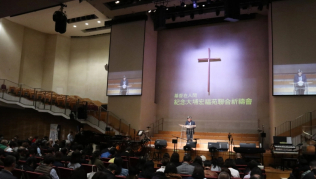The Global Village and Discovery Center (GVDC) of Habitat for Humanity International has literally taken possession of The Great Commission—the sculpture that is. Dedicated on April 1, the symbolic sculpture located in the entrance of the six-acre educational center serves as a reminder to visitors of Habitat’s ongoing mission to fight poverty housing.
“The sculpture is the first thing you see as enter the center. It’s an anchor for that place and really focus people’s attention on the worldwide mission,” said Michelle Dalva, executive director of the GVDC. “We are a Christian evangelical organization. We believe our mission to eliminate poverty through housing is our way to proclaim God’s love to everyone. ‘The Great Commission’ is the earth suspended with two open Bibles, which I think is very significant. It really speaks to the foundation upon which the organization was founded on.”
Inscribed on one Bible are verses reading, Unless the Lord builds the house, its builders labor in vain” (Psalm 127:1), and "I was a stranger and you invited me in ... whatever you did for one of the least of these brothers of mine, you did for me -- Jesus Christ” (Matthew 25:35, 40).
The second Bible reads: "For God so loved the world that he gave his only begotten Son, that whosoever believeth in him should not perish but have everlasting life -- Jesus Christ” (John 3:16), and "Heaven and earth shall pass away, but my words shall not pass away -- Jesus Christ” (Matthew 24:35).
In attendance at the dedication was Millard Fuller, the founder of the largest nonprofit, nondenominational Christian housing organization, and Dr. Gary Cook, president of Dallas Baptist University who donated the sculpture.
“Dr. Gary Cook is a visionary and believed in the future and especially in the future of students—how they had the ability to change the world,” stated Dalva. “He wanted to honor the vision of Millard and Linda Fuller through this sculpture. It’s for all the student campus chapters of Habitat.” Cook founded the first chapter of Habitat in 1987 while he was a professor at Baylor University in Waco, Texas.
Although only Cook and Habitat co-founder Linda Fuller participated in unveiling the sculpture, Davla said the development of Habitat’s mission and center has been the possible through the encouragement of a global community effort.
Surrounding the sculpture is a brick plaza featuring bricks inscribed with the names of donors who have contributed $100 or more to the center. “We feel as an organization that anyone even with moderate means can become involved in this mission and how it would not happen without the support of our friends and donors,” said Dalva, who has been involved with Habitat for 13 years ever since she was a college student at the University of Wisconsin.
The 30-year old organization has been able to help approximately 1 million people living in 92 countries.
However, the mission of Habitat is far from being fully accomplished. With the development of the GVDC, organizers are hoping to raise awareness of Habitat’s mission to new audiences and encourage their participation to address the dire need of decent housing.
She said the center, which has already fully completed 12 houses, with 3 in progress and an extensive exhibit of urban poverty, will not only be “a place where people come to experience the Habitat story hands-on and first-hand how awful poverty housing can be,” but also come to see that Habitat “has the solution to this.”
The center is funded entirely based on donations directed for the specific purpose of building the center. Labor for the houses and projects on the site are provided by a variety of volunteers ranging from full-time volunteers who fly in from abroad to student groups. Around 7-10 student groups visit the site every week, up to 300 students a group.
On the day of the dedication, a student group from Northwest Cabarrus Middle School in Concord, N.C. came to visit the site. They are one of the many groups who have “taken the challenge” to eliminate poverty housing in their community, according to Dalva.
After the dedication, attendees were led on a tour around the center. The first project they encountered was the Living in Poverty section, a recreated community to represent the typical living conditions in Latin America, Africa, Asia,
“It's a chance to see what it would be like to live in community that has poverty housing,” explained Dalva. “Folks in poverty live their whole life there. Often times people die very young in their 40s. It’s a short hard life, hard on the soul and on the body.”
Although the houses Habitat builds for people in need, usually made of concrete, it is guaranteed that these are the type of houses these families would want to live in, said Dalva. “The houses need to be a blessing not a burden.”
Visitors are offered an opportunity to “see the flavors of cultures” by doing hands-on activities such as making blocks that would be used in the houses in the center.
“I would like to invite anyone to come and join us,” said Dalva.
Those interested in participating in volunteering at Habitat’s Global Village and Discovery Center can call 866-924-5823.







